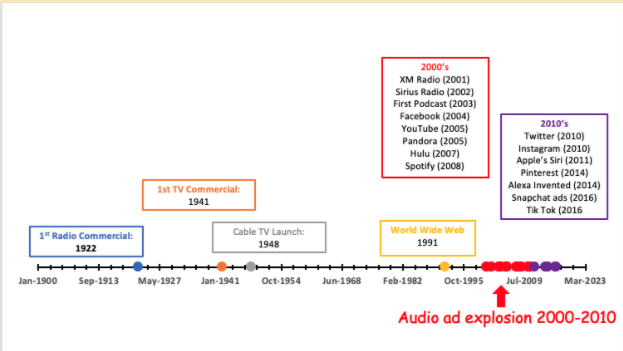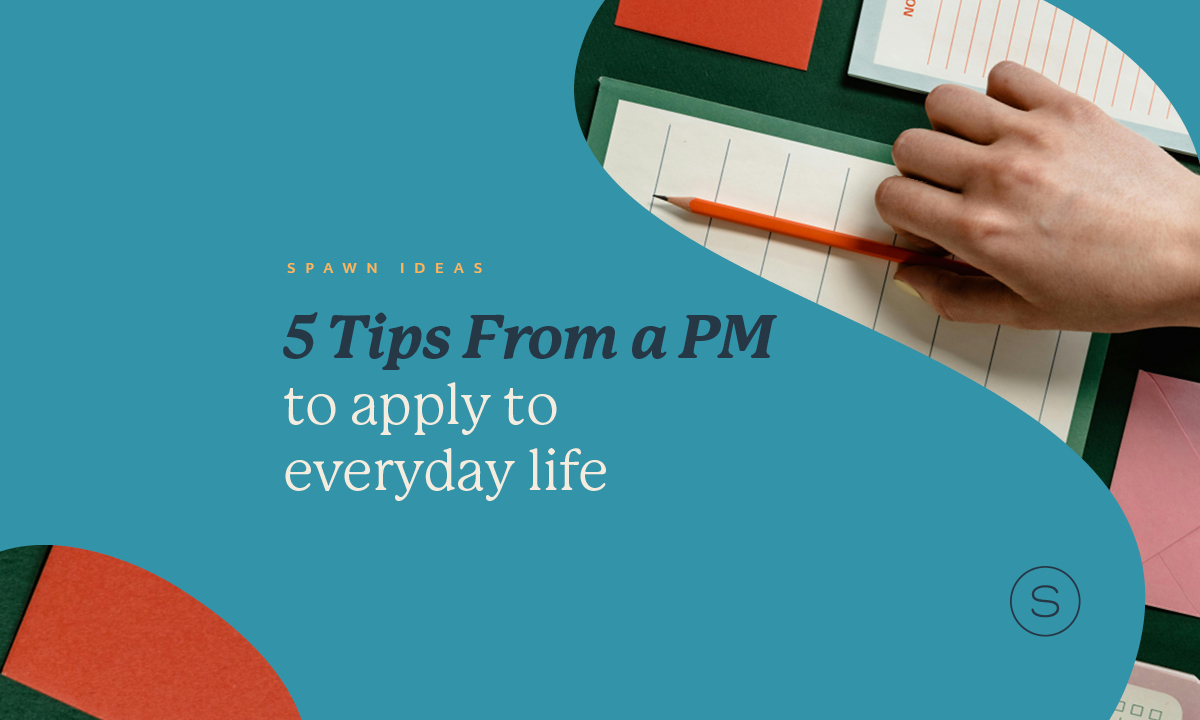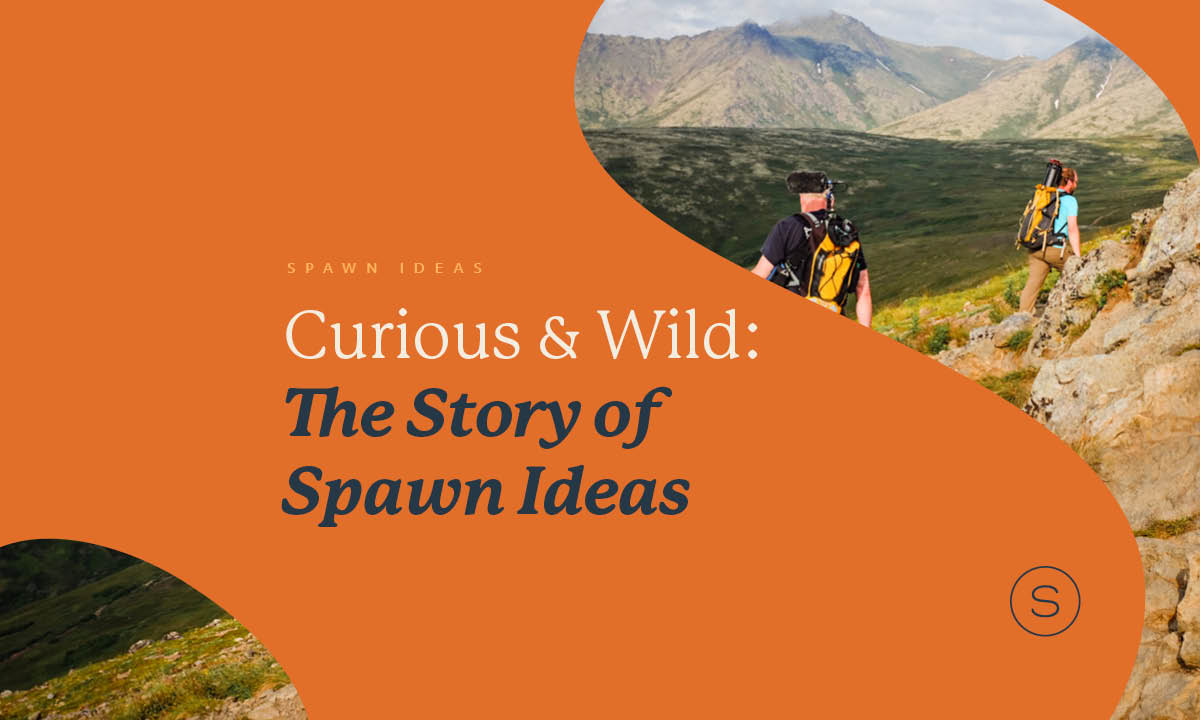Five years ago, it was predicted that all digital video would need to be produced with the intention that it would be viewed with no sound. (1) So how did we get to a place where the relevance of audio is once again at new heights? Where ABBA is experiencing a resurgence and goofy audio clips become fast culture? Where podcasting has become one of the most popular ways to learn new information? Where will audio go next?
In advertising, we seek to be memorable and relevant. Spawn’s very own Associate Creative Director, Amy Adams, reflects that sometimes when concepting a new ad – the first thing she considers is how audio will play its part to increase the impact of an ad. From sound effects to jingles, to popular music and beyond, audio is not only a basic ingredient of effective advertising, but an ingredient that we must measure with accuracy to make the recipe (or ad) worth consuming.
The impact of audio in advertising makes sense, as research supports an intimate connection between sound and action. “We are conditioned to respond to a sound on instinct to protect ourselves, more so than any kind of visual cue. Our ears are wired directly into the action centers of our brain, while visuals go through layers of analysis before we react.” (2)
First, A Little History on the Role of Sound in Advertising
Before the first radio ad aired in 1922, advertisers relied on visuals and written word to establish an association with the consumer in newspapers or posters. “Radio liberated advertising from its relationship to literacy by communicating through music, jingles, and the spoken word.” (3)
If radio was the superhero of the 20th century, the jingle was its reliable sidekick. Wheaties is believed to be the first brand to produce a singing advertisement, aka a jingle, and it aired just a few years after radio hit the airwaves. This is no coincidence. The jingle experienced its massive success as radio made its debut because – just like every other new and exciting innovation – everyone wanted to be a part of it; everyone was listening. For the first time, brands wanted consumers to associate them with particular sounds. When sound is aligned to a brand, ad recall increases as much as 60%. “…sound, and especially music, can enhance memory and motivate listeners to take action.” (3)
Radio continued to carry all audio advertising until the first TV commercial aired for Bulova watches in 1941. (4)
This first commercial kicked off the future of TV ads, combining visuals and audio together, and eventually adopting the radio jingle, making snippets of audio ubiquitous and burned into the memories of generations to come.
In the years that followed, the advertising industry would produce a miles-long playlist of catchy tunes, which were intended to create an inseparable link between brand and consumer. Brands like McDonald’s, Folgers Coffee and Lucky Charms successfully utilized jingles over the years, and are included in a recent most memorable list. (5)
But eventually, the jingle lost its place as the standard, and by the end of the 20th century, advertisers realized that the jingle wasn’t the only way to cut through the noise. Beginning in 2001, audio platforms were exploding as several new media ventures launched, creating a fragmented audio environment.

These new platforms posed a new challenge to the advertising industry: How could you cut through the noise and once you did, how could you be certain that your message would be heard?
In order to establish a connection strong enough to make noise in an already noisy environment, brands had to adapt their use of audio to be more targeted, reaching audiences when and where they were listening, in a world with no shortage of options to choose from.
The Role of Sound in Advertising Today
Podcasts have seen huge growth in recent years, with listenership increasing 100% since 2015. (6) Podcasts keep the listener’s attention based on the ability to choose specific content and listen on your own time. The format also supports multitasking behavior, since you can listen on the go. Over 80% of listeners report finishing entire episodes, as opposed to checking out before the end. (7) The Edison Research/Triton Digital survey also found that 54% of podcast listeners were either somewhat or much more likely to consider a brand after hearing it advertised on a podcast. (8) For all of these reasons, podcasts are a great environment for really creative audio that will connect with consumers.
We would be ignoring an influential audio platform if we didn’t talk about social videos. As mentioned above, predictions were that social video would need to be produced for a sound off environment. There are some brands that have embraced this approach, like Tasty videos where the audience has the ability to learn how to make Swedish meatballs in 60 seconds without ever having to turn up the volume. (9) “While most of these videos feature narration or some form of background music, the intent is to make it easy for people to consume the information presented in the videos without needing to turn the sound on. (1) Thus, the role of audio is dialed down but still ever present.
Now, the app which just reached 1 billion monthly users (10) and is still growing rapidly – TikTok. The vast majority of TikTok trends actually revolve around audio. Video creators on TikTok have all sorts of tools at their disposal, but the platform’s feature to search for sounds is of most relevance to our exploration around audio, and telling of audio’s persistent relevance, despite earlier predictions. (11) This is a tool that Instagram (Reels), Facebook, Twitter and Snapchat have now incorporated into their platforms. Audio is a powerful tool to capture attention, create excitement, and initiate creativity, as seen in this sampling of a few TikToks and Instagram Reels set to popular sounds/songs:
TikTok has revolutionized the relationship between audio and social media for now, but what does that mean for user behavior and for advertisers moving forward? How do we use audio to break through and get consumers to listen to our messages?
There are four key tips to use sound to break through the noise:
- Use data to understand your audience
The key to delivering breakthrough audio is understanding who your current customers are and harnessing existing data from both your website and current campaigns to help define them. As privacy laws take effect over the next few years and walled gardens limit the cookie and 3rd party data segments that are available, it will be imperative to lean into your own 1st party data, both online and offline. (12)
- Define how they consume audio on different devices and platforms
The next step is understanding your audiences’ daily routines and media consumption so you can develop an impactful plan that is aligned with their behavior. This process helps define which tactics to include. Then, use audio research that shows how listeners respond to sound on each platform to create an impactful sound on campaign.
Harnessing data to inform audio decisions is the best approach to make an impact and will help identify useful insights about how audio in ads can be personalized. We are all excited for the day when personalized creative can be deployed using addressable media (13) for all sizes of businesses and markets, but for now this technology is limited to the large brand players and national campaigns.
However, we can still deliver a more addressable campaign right now. An article from Forbes suggests using a Green Day song to reach new prospects based on data that indicates Green Day is the favorite band for current customers. (14) This strategy can be deployed without the ad tech of addressable media by using generational audio that plays different songs for the same video depending on the platform. For a Gen X audience on Pandora, the music would be Nirvana, while Spotify could be targeted to 30-year old millennials and they hear SoundGarden (to keep the Seattle vibe).
It’s also important to consider device strategy and the importance of continuing and accelerating a mobile-first advertising approach based on the time spent on mobile devices, which continues to grow. Understanding how audio is consumed on mobile, depending on the app being used, will help to personalize audio and authentically connect with users.
Matching the audio to the platform is just as important as the visual to catch the user’s attention. Overall, the results for this particular ad showed a 21% increase in response compared to previous placements that were more-traditionally produced, and it generated sustained excitement and positive feedback from the client.
- Develop ads that will speak to them in context of what they are listening to
We can also create audio ads that speak specifically to a contextual audience, which aligns with contextual media placement strategies vs. behavioral, since we know behavioral segments will be harder to target in the near future due to the changes in cookie data and privacy issues that we discussed previously.
Here’s an example:
Looking at the growing podcast audience, we know that two of the most popular genres are comedy and true crime. (15) If we dig into the research a little further, we see that the gender skew for podcasts in general is 56 percent male/44 percent female while true crime podcasts overwhelmingly skew female. (16, 17) The true crime obsession that started with Dateline and America’s Most Wanted on TV has inspired over 200 podcasts based on a Wikipedia list (that notes the list is incomplete) and has recently inspired a Hulu series by Steve Martin called “Only Murders in the Building.” While we typically recommend our clients steer clear of advertising in the true crime genre, there might be an opportunity for a client whose audience is overwhelmingly female to develop an ad that speaks to this audience in an interesting way, aligning the audio with the theme. Think about a suspenseful music bed that supports ad copy delivering a product message as a true crime introduction. It could be a fun way to break through ad noise and develop a brand affinity with a specified audience.
- Deploy the right media tactics that align with the overall strategy
It seems obvious that just adopting the latest audio trend to advertising is the way to go; however, it isn’t easy since consumers, particularly younger generations, are very savvy to ads and aren’t always receptive when brands jump into their world.
There are some brands like Hollister who are currently doing this well by using top TikTok talent Charli D’Amelio to appeal to their core teen audience, but it won’t work for everyone. So tread carefully, and don’t just repurpose your other online videos on these platforms.
Audio will continue to be irrevocably paired with media moving forward. The important thing is to find ways to use audio correctly in order to make a connection with the consumer in a very noisy world.
Works Cited
- Patel, Sahil. “85 percent of Facebook Video is watched without sound”. Digiday May 17, 2016, https://digiday.com/media/silent-world-facebook-video/
- “Brain Study Appears to Link Sound and Music to Ad Value” Inside Radio via Scientific American October 13, 2021 http://www.insideradio.com/free/brain-study-appears-to-link-sound-and-music-to-ad-value/article_e709c50a-2405-11e7-9248-0bde22f43bee.html
- O’Barr, William M. “A Brief History of Advertising in America”. Advertising and Society Review, Volume 3, Issue 6 2005, https://muse.jhu.edu/article/193868
- “Bulova: World’s first television commercial. YouTube https://youtu.be/8JenAyMmZ68
- “What are the Catchiest Jingles of All Time”. Quality Logo Products Blog September 21, 2021, https://www.qualitylogoproducts.com/blog/the-catchiest-advertising-jingles-of-all-time/
- Lin, Ying. “10 Powerful Podcast Statistics You Need to Know in 2021”. Oberlo July 5, 2021. https://www.oberlo.com/blog/podcast-statistics
- Ben. “Why are Podcasts so Popular in 2021?”. Brandtastic February 8, 2021, https://brandastic.com/blog/why-are-podcasts-so-popular/
- Droesch, Blake. “Podcast: A Small but Significant Audience” Emarketer April 19, 2019, https://www.emarketer.com/content/podcasts-a-small-but-significant-audience
- “Tasty’s Best Dinners of 2020”. YouTube https://www.youtube.com/watch?v=t6PifI-7QBg
- Silberling, Amanda. “TikTok reach 1 billion monthly active users” Techcrunch.com September 27, 2021, https://techcrunch.com/2021/09/27/tiktok-reached-1-billion-monthly-active-users/
- Herrman, John. “How TikTok is Rewriting the World” The New York Times, March 10, 2019, https://www.nytimes.com/2019/03/10/style/what-is-tik-tok.html
- Bump, Pamela. “The Death of the Third-Party Cookie: What Marketers need to know about Google’s 2022 Phase Out” Hubspot.com September 20, 2021 https://blog.hubspot.com/marketing/third-party-cookie-phase-out
- “Addressable TV Advertising: Creating a Better, More Personal TV and Video Experience” Think With Google. June 2016 https://www.thinkwithgoogle.com/marketing-strategies/video/addressable-tv-advertising-personal-video-experience/
- Newman, Daniel. “Where Does Audio Fit in the Future of Marketing” Forbes January 22, 2020 https://www.forbes.com/sites/danielnewman/2020/01/22/where-does-audio-fit-in-the-future-of-marketing/?sh=6f6415222fd8
- Statistica Research Department. “Most Popular Podcast Genres in the US 2020” Statistica.com March 4, 2021 https://www.statista.com/statistics/786938/top-podcast-genres/
- “2021 Global Podcast Statistics, Demographics and Habits” podcasthosting.org April 10, 2021 https://podcasthosting.org/podcast-statistics/?gclid=CjwKCAjwndCKBhAkEiwAgSDKQXfY1H5EnSqbUb1TCy7VGO4C1rTebqRvUAnwGEP28Fc_5fe7SmnxIhoCKUUQAvD_BwE
- Colin, Ned, and Nick Fouriezos. “Why True Crime Is Podcast Crack – for Women.” OZY. 14 Dec. 2019. Web. 26 Oct. 2021 https://www.ozy.com/good-sht/why-true-crime-is-podcast-crack-for-women/94331






